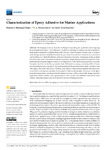Characterization of Epoxy Adhesive for Marine Applications

Use este enlace para citar
http://hdl.handle.net/2183/40539
Excepto si se señala otra cosa, la licencia del ítem se describe como Attribution 4.0 International https://creativecommons.org/licenses/by/4.0/
Colecciones
- Investigación (EPEF) [590]
Metadatos
Mostrar el registro completo del ítemTítulo
Characterization of Epoxy Adhesive for Marine ApplicationsFecha
2024-12-02Cita bibliográfica
Rodríguez-Dopico, F.J.; Álvarez García, A.; Tarrío-Saavedra, J. Characterization of Epoxy Adhesive for Marine Applications. Oceans 2024, 5, 906-922. https://doi.org/10.3390/oceans5040052
Resumen
[Abstract] The shipping industry faces the challenge of expanding its capabilities and mitigating its environmental impact. The utilization of adhesive bonding techniques has the potential to facilitate the construction of lighter ships with a reduced carbon footprint. In this work, a complete methodology has been established to study the properties of an adhesive bond between naval steel and the behavior of the bulk adhesive when introduced into seawater. Thermogravimetric analysis (TGA) has been used to determine the thermal properties. Single-lap-joint and tensile tests have been performed showing the negative influence of temperature on the mechanical properties. Seawater absorption has been studied by gravimetric tests. Differential scanning calorimetry (DSC), Fourier transform infrared spectroscopy (FTIR), and mechanical bulk tests have been carried out before and after aging. The water absorption is Fickian, and when a constant load is applied, the absorption occurs faster and in greater quantity, decreasing the stiffness and strength. An increase in the glass transition temperature was observed in the absence of a load, with no discernible change upon the application of load condition. Also, aged specimens with constant load exhibited a reduction in water content. These phenomena may be attributed to several diffusion processes.
Palabras clave
Adhesive
Diffusion
Aging
Seawater
Marine
Mechanical tests
Diffusion
Aging
Seawater
Marine
Mechanical tests
Versión del editor
Derechos
Attribution 4.0 International https://creativecommons.org/licenses/by/4.0/
ISSN
2673-1924






